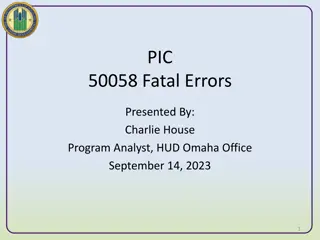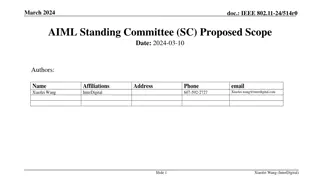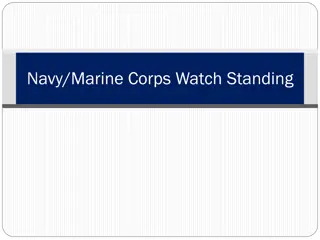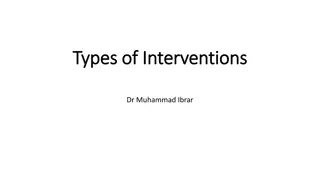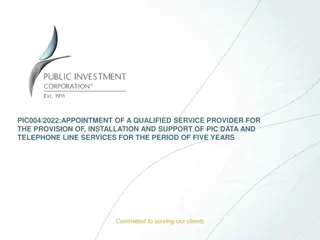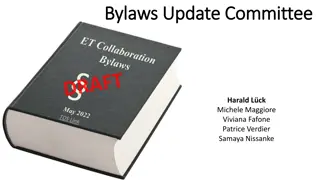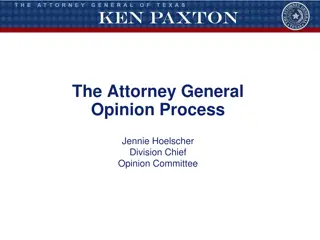Request for Intervention from Standing Committee on Finance in Matters Involving MMI and PIC
Matome Maponya Investment (MMI) Proprietary Limited, along with related entities and the Public Investment Corporation (PIC), seek intervention from the Standing Committee on Finance. MMI, a company founded in 1995 focusing on investment, agro-business, retail, property, and lifestyle offerings, is led by Kholofelo Maponya. MMI emphasizes sustainability, community participation, and diversification in its market structures. The company is currently expanding with 2U Foods, a retail brand targeting economic empowerment of disadvantaged South Africans.
Download Presentation

Please find below an Image/Link to download the presentation.
The content on the website is provided AS IS for your information and personal use only. It may not be sold, licensed, or shared on other websites without obtaining consent from the author. Download presentation by click this link. If you encounter any issues during the download, it is possible that the publisher has removed the file from their server.
E N D
Presentation Transcript
Request for intervention from Standing Committee on Finance in the matters between Matome Maponya Investment (MMI) Proprietary Limited, Our Related Special Purpose Vehicles (SPVs), Other Group Entities and Public Investment Corporation (PIC) 1
MATOME MAPONYA INVESTMENT (MMI) MATOME MAPONYA INVESTMENT (MMI) PROPRIETARY LIMITED PROPRIETARY LIMITED Presenters Mr Zacharia Mogotsi Ms Lindiwe Mthembu Mr Kholofelo Maponya 2
MATOME MAPONYA INVESTMENT (MMI) PROPRIETARY MATOME MAPONYA INVESTMENT (MMI) PROPRIETARY LIMITED LIMITED Introduction Matome Maponya Investments (Pty) Ltd (MMI), a dynamic and progressive company, founded by Mr Matome Maponya and now led by his son Kholofelo Sekepe Maponya. MMI is a company built on solid heritage and sound business integrity that provides consistent, high quality Investment, Agro Business, Retail, Property and Lifestyle based offerings. Registered in 1995, its core focus is within the property business and agriculture spanning from development to management and retailing, to this end MMI, has developed many townships and malls from scratch. MMI strives for diversity in order to insure its sustainability. Its investment interests is spread both horizontally and vertically in terms of market structures. MMI and the Maponya family have been involved in various farming activities in Limpopo and Mpumalanga since 1976 and have successfully run cattle, poultry, small livestock farms, Abattoirs, Butcheries, Supermarkets & Restaurants . Thus, it seeks to facilitate reformed programmes based on intensive participation of the community in the identification, planning, implementation and financial management of their projects. MMI holds investments through their trading, operational and property businesses. 3
MATOME MAPONYA INVESTMENT (MMI) PROPRIETARY MATOME MAPONYA INVESTMENT (MMI) PROPRIETARY LIMITED LIMITED Introduction (Continued) MMI is currently rolling out 2U Foods 2U Foods is a retail brand, founded by MMI, directed at increasing the economic participation of previously disadvantaged black South Africans by providing access to Retail Panel Supermarket business opportunities with minimal barriers to entry. Our business model is premised on carefully selected distribution centres operating at buying group level, aimed at providing retail supplies to containers located in townships and rural areas which in turn will provide access to basic goods to a segment of the population who would not otherwise have access to these goods or may be classified as low-income segment. The model is designed in a way that sets suggested pricing at group level for all 2UFoods Panel Supermarkets across the country and this ensures that our pricing is uniform and competitive against established retail chains, spaza shops. 4
MATOME MAPONYA INVESTMENT (MMI) MATOME MAPONYA INVESTMENT (MMI) PROPRIETARY LIMITED PROPRIETARY LIMITED Introduction (Continued) Up to this point,2UFoods has been funded through personal balance sheet though, through various integrated business models the business has demonstrated a pre-feasible and feasible commercial vialibity. The resistance or apprehension to funding this model if the business were to hazard a guess has no reason based on scalability and future profitability, but on personal ambition to oppose any initiative associated with MMI and an unexplained need to protect an already demographically skewed retail market at the expense of the consumer who in this case again are the poor. 5
MATOME MAPONYA INVESTMENT (MMI) PROPRIETARY MATOME MAPONYA INVESTMENT (MMI) PROPRIETARY LIMITED LIMITED Opening Statement The leadership at the PIC, the former and its current structure, has severely derailed from its mandate which is Exceeding client expectations while investing for sustainable growth, inclusivity, and transformation . What has transpired over the years and has culminated in the Mpati Report reflects the exact opposite; this at the expense of entrepreneurs and the previously disenfranchised. As it stands the senior executive management of PIC has attained quite the reputation over the years of failing to put the interests of its clients and the country at the centre. This is particularly due to their non competence in dealing with non listed organizations and entrepreneurs due to their structure and skill sets. A problem Dr Dan Matjila recently lauded to taking learnings and the fact that he was still in the process of building this very necessary competence and division due to its infancy on Radio 702. We unfortunately happened to be part of an experiment in this process and the results of how they reacted and dealt with us and our assets and livelihoods in this process of experimenting is appalling and heartless. We need the PIC to own up to their mistakes and knee-jerk reactions and correct the mistakes and work with us in assisting them to understand the non listed entrepreneurial space 6
MATOME MAPONYA INVESTMENT (MMI) PROPRIETARY MATOME MAPONYA INVESTMENT (MMI) PROPRIETARY LIMITED LIMITED Opening Statement (Continued) The purpose of the Judicial Commission of Inquiry into PIC was to enquire into, make findings, report, and make recommendations on cases before it ranging from one era to an end. We did not fall within that but had actually previously written letters of complaint to the Chairpersons and to previous Ministers. We actually thought the commission was there to do what we are here to seek from the Committee, which is give directions to investment continuation and not stop it. It is the mandate and duty of the PIC to put the money to work in a proper environment. However, as a cited party and in the face of condemnatory allegations, neither Mr. Maponya nor MMI were afforded the opportunity to state their respective side and to present their case. Therefore, there is a need for the grieved such as ourselves to find other avenues to be heard and find resolve for the interests of accountability and delivery. Our grievance with the PIC centers primarily around our agricultural and human settlement interests, and as such, we shall for the sake of brevity, focus on our disagreement relating to Magae Makhaya (RF) Proprietary Limited ( MMH ), SAHL Investment Holdings Proprietary Limited ( SAHL ) Bafepi-Afgri (RF) Proprietary Limited ( Bafepi ) and Afgri Poultry Proprietary Limited, t/a Daybreak ( Daybreak ). 7
PROBLEM STATEMENT PROBLEM STATEMENT The mistake the PIC makes first is assuming they can run a business from their offices as opposed to trusting the investee as a partner/jockey which is the main reason why they partner in the first place. Secondly, the PIC assumes that once they have funded an entrepreneur, it is their business and no longer the entrepreneur's business and dictate how it should be run instead of concentrating on governance and support ( management styles according to them are governance issues). Upon realizing the full potential of our ideas and projects we then start competing with our lenders, their employees extended interests, unions, those of politicians and the financial economy apparatus of banks, insurance companies and pension funds of, which the PIC is a big member of, but without direction and control( in other words, it is a dog wagged by the tail). It just so happens that almost everything new happens to be in conflict with their existing interests or investments or should partner with those and enhance them instead of introducing fresh ides and competitive. This is the main reason the South African economy has not been growing and is not poised too. Hence, even though the term was crafted by unpopular people, it is still relevant WMC ( White Monopoly Capital The PIC is an enabler of continued privilege, uncompetitive behaviour, non transformation and stifling of growth. 8
WHAT DO WE WANT TO ACHIEVE THROUGH THIS DIALOGUE WHAT DO WE WANT TO ACHIEVE THROUGH THIS DIALOGUE 1. Overall reform in the business relationship It has been personalised and needs to be more professionally structured . Therefore, we are seeking an amicable and wise solution to outstanding issues. Magae Makhaya Reinstalment of facilities The finalization and satisfaction of conditions precedent on the Development Fund SAHL Settle on the balance on profit participation Bafepi Agri Settle of share at current value. Purchase of share at current company value at 20%. Daybreak Reinstatement of shares 2. 3. 4. 5. 9
MAGAE MAKHAYA PROPRIETARY LIMITED MAGAE MAKHAYA PROPRIETARY LIMITED Background We initially approached the PIC in 2009 after the financial crisis and only got to a point of a formal fund presentation in 2011. MMI identified the gap market in 1997, approached government about our own farms, got a middle-income subsidy in 2001, had been in this market ever since and approached the PIC in 2011 ( see attached proposal by MMI through Vunani Capital, Annexure 1). There had been reference to this market as the missingmiddle because members of this group do not usually earn sufficient income to enable them to obtain a bond from existing financial institutions. They do not qualify for Government subsidies because their income exceeds the prescribed income for such subsidies. We approached the PIC the establishment of a fund and a development company that would be responsible to provide housing stock as well as to bring the civil servants and/or other clients from the missing middle market to obtain housing loans from SAHL. We embarked on a process for the establishment of the fund (known as the South African Housing Development Fund ( Fund ) and a development company ( MMH ) as well the requisite funding lines (which MMI arranged). We formally approached the PIC with the idea to develop homes and fund the end user (in particular the missing middle). 10
INVESTMENT RATIONALE INVESTMENT RATIONALE The establishment of a fund and a development company was proposed. They would be responsible for provision of rolling housing stock in order to bring civil servants and/or other blue collar clients from the missing middle market to obtain houses from Magae Makhaya and housing loans from SAHL. Overall wellness benefits and financing discounts for GEPF members. In excess of 10 000 construction jobs per annum at peak. Black experienced developers with a black professional team since 1996. High impact volumes and roll out of rolling stock in a market at preferential pricing in market with increasing backlog. Strong financial returns and recurring growth in the market. 11
PIC INVESTMENT PIC INVESTMENT R500 million for land acquisition against land parcels of R 600 million already owned or under the management of MMI which the funding will acquire at market rates with development right potential R1.5 billion- Infrastructure development fund to install services and buildings in support of the company 12
CHALLENGES POST INVESTMENT CHALLENGES POST INVESTMENT 1. Drawdowns were used as an instrument to have negative control of the company with us as stooges. We abandoned our first court summons upon agreeing to change the MOI to allow installation of third parties by PIC. Drawdown procedures and company policies changed each time PIC officials did not get their way as they refused the second one because we appointed a third party CEO who was not their nominee but head hunted. The position was not necessary and not in our agreements but was to be used to control our company and debt we stood sureties for. The agreements started being misinterpreted and translated into understandable things that did not make sense e.g. projected two year expense to be paid in advance were broken into five years because there was a clause that said within 5 years. Third parties were being forced on us for partnership. Our infrastructure fund was converted to a public fund over supporting us instead of us screening and managing third parties after we refused to entertain a few bad proposals in advance of the fund being formed. Those people then went to work for the fund with those projects . 2. 3. 4. 5. 13
SA HOME LOANS INVESTMENT HOLDINGS SA HOME LOANS INVESTMENT HOLDINGS PROPRIETARY LIMITED (SAHL) PROPRIETARY LIMITED (SAHL) Background JP Morgan, an International Finance Institution who owned a 50% stake in SAHL, was in the market to sell their shares and willing to negotiate the sale of their stake in SAHL with any party that has the ability and support to close the transaction. The consortium sought to contribute to holistic housing solutions for lower- middle income working class in South Africa and had already submitted a proposal to the PIC that included end user financing. MMI made a compelling argument to the PIC in terms of an end-to-end vehicle/s with an industry player/jockey in the value chain. As opposed to proposals they had already received from other parties including the sellers and associated parties. MMI financed, facilitated and negotiated the Buy Out of J P Morgan Shares in SA Home loans (SAHL) (Pty) Ltd. We approached JP Morgan and we negotiated and entered into an agreement for the purchase of the 50% shareholding in SAHL. PIC insisted that they wanted to participate with us in a 50:50 joint venture partnership, with them bringing funding and us delivering housing products and that in the event of any capital calls, they would assist us with the requisite funding. Each party was to incur its own cost, the upside of the raising fees would be shared equally upon success of the transaction (MMI committed funds at risk ). a 14
INVESTMENT RATIONALE INVESTMENT RATIONALE We approached the PIC with a compelling value proposition. Partnership- end to end with financier, developer and financial instrument. Platform for PIC members. Platform to enable MMI (Magae Makhaya clients). Social Return on PIC Capital. Transformation of the value chain.
SO CALLED ARRANGING FEES SO CALLED ARRANGING FEES We agreed to take on all costs on our side without an engagement letter as we clearly had an in-principle 50:50 partnership and would share the raising fee in that manner. We later, at the request of the company (SAHL), remove the raising fee in favour of GEPF members, agreed to a reduction in the fee by removing PIC participation only as we could not afford to waive overheads and they were in the open. Given our involvement in the establishment of the fund and arranging the loan, we had an agreement with the PIC that MMI would be entitled to participate on a 50:50 basis in the raising fee ( NB. Not Arranging Fee) as per our in-principle partnership when we gave away 50% shares to them as a beneficial partner (NB. Any funder could fund without taking shares, but we chose to have one that backed us on calls and shared upside with us, hence the 25 was split). The arrangement fee has been disputed and thus not honoured by the PIC and SAHL. MMI therefore suffered a financial loss from utilising its financial resources for professional consultations, including man hours, logistical and housing costs for company and staff across the country; as well as other setup cost over the period starting in 2009 to close in pursuit of establishing the funds. The arranging fee as termed by the SAHL & PIC officials, upon request of how our invoice and subsequent agreement and mandate letter should be structured and we submitted back and forth invoices with amended descriptions as has been norm due their practice of not entering into agreements prior to us spending our own resources in having a tight and sealed transaction was then disputed after both SAHL and PIC went back and forth as to how it should be paid. 16
BAFEPI BAFEPI- -AFGRI PROPRIETARY LIMITED AFGRI PROPRIETARY LIMITED Background In 2014, Maponya Hofman Sechaba Proprietary Limited acquired a commercial farm, which among others specialized in rearing poultry for commercial purposes. This farm was adjacent to a poultry farm owned by Afgri Poultry Proprietary Limited (now trading as Daybreak Farms) The consortium was established to provide agri solutions for Subsistence and emergent farmers in Southern Africa. Our turn-around plans for the farm (Daybreak) and our profile as business-people, piqued the interest the CEO of Afgri and informed us that Afgri would be de-listing, with management buying a controlling stake in the business. We were invited to participate in the transaction by Fairfax (a Canadian investor and management) as active value adding BEE partners, we accepted the invitation. PIC was invested in Afgri and had diluted its shareholding to under 5%. We informed them of our intended participation in the management buy-out and convinced them to participate on the basis of the impact the business could have in empowering black farmers. This included convincing them to move back into an investment they had practically exited at our own cost with back-to-back meetings on three continents over an extended period of months. 17
INVESTMENT RATIONALE INVESTMENT RATIONALE 1. Use it as a tool to empower, fund and train emerging farmers like in SAHL GEPF products ( the funding didn't happen, instead subsidiaries were created with different directors and BEE structure. 2. The Silos were to be protected and bought by PIC in case the foreign partners wanted to take them out of reach of communities ( they are currently owned and controlled by the Financial Economic Complex By Design and Sideline of our voice) 3. It was to be an instrument to have South Africa reestablish itself in Sub Saharan African Agriculture ( the opposite was attained by hard-line approach against African states) 4. The value chain was supposed to be taken further in supporting us in the poultry and our main project of retail ( Later became 2ufoods) we were given ultimatums to fall in line and maintain existing monopolies in which PIC and other funders who were upset by my rattling the boat were invested. To date I refuse to see logic in this myopic anti competitive corrupt approach. I actually see everyone growing and segmenting themselves into better competitors 18
POST INVESTMENT POST INVESTMENT The PIC and our investment entity Bafepi Afrgi (RF) Proprietary Limited ( Bafepi ) entered into a voting pool agreement in terms of which we agreed to vote together on certain matters. The investment became a two party relationship between two big balance sheets with unlimited funds as opposed to an operational business. The investment and business case moved from operational returns to an investment one our agreements and mandates were not adjusted nor were we supported in the capital calls. Dividends could no longer be paid as per our projections and investment case due to policy change (PIC continued to compound interest). We were excluded from operations completely against the spirit of our funding agreement and voting pool agreement. 19
AFGRI POULTRY PROPRIETARY AFGRI POULTRY PROPRIETARY LIMITED (TRADING AS DAYBREAK) LIMITED (TRADING AS DAYBREAK) 20
INVESTMENT RATIONALE INVESTMENT RATIONALE Motivation for PIC s Investment Motivation for PIC s Investment Creation of impactful black participation in food security with Maponya having been in the poultry business with family since 1987. Disrupting a traditionally difficult market for black entrants with an integrated value chain. Financial statements were not strong; however a turn-around plan provided the strategy to resuscitate the business. In addition, due to several factors including cheap imports (dumping), the sector was experiencing contraction and 3,000 jobs were at risk. Daybreak provided a compelling developmental investment for PIC to participate in. 21
THE PIC INVESTMENT THE PIC INVESTMENT Debenture - R 892 million Senior Debt- R 299 790 000. Working Capital R 100 million was not advanced. Acquisition Finance R1.05 bn Value of Assets Acquisition of Kinross- worth R 290 million( negotiated by Maponya and added by Afgri . Net value was not funded. Overall Net value R 620 Million. Shareholding Undertakings 22
CHALLENGES POST INVESTMENT CHALLENGES POST INVESTMENT The farm was over capacity, and it would cost an additional R70 million to address its capacity constraints. Following the acquisition, we submitted a request for working capital in the amount of R100 million as agreed in the projections ,plus the additional R70 million needed to resolve Daybreaks capacity constraints created by the Big Bird Phenomenon (attached as Annexure 2) The PIC refused, in addition, it took security over the assets of Daybreak. PIC further withheld assets that would have allowed third parties to fund the company on several occasions. As a result of the PIC s actions, Daybreak s trading accounts were severely compromised, and it lost R600 million in trade facilities which translated to a halt in activities. But we manouvered and creatively sustained operations. Micro management of the funded company and in discussion with non-performing staff and service providers as well working on hearsay. 23
CHALLENGES POST INVESTMENT CHALLENGES POST INVESTMENT Legal agreements We were forced by the PIC to honour legal agreements that adversely affected us. Disbursements We were made to pay for costs that were astronomical and not market related. 24
LITIGATION: OUR SYNOPISIS LITIGATION: OUR SYNOPISIS Why are we here? Why did we go to court? Have our agreements in a court settlement to avoid further changes at next draw down. Why is PIC not settling but pursuing court with costs? Is pursuing court the only option for PIC? Seems like deflection of decisions at worst but malicious delaying tactics to bankrupt us as they don t pursue the cases and delay them by all means just to keep them in the system and pending after Committee indicated that they could not entertain pending cases. Hands ball mentality! Relegation of decisions to courts. Supreme Court of appeals ruling in December 2020 (attached as Annexure 3). 25
SNAPSHOT SNAPSHOT Number of jobs and incomes affected by purging. Strategic loss to workers and the fund versus stopping GEPF facilities due to payment to a black man. We had and have nothing to do with PIC internal processes but are very clear on what we came to do, agreed on and delivered our end and expected in return without debating what will be debated in court. Recent news events about Daybreak corroborates our case. Losses on questionable housing schemes 26
EFFECTS ON MMI STAFF, SERVICE PROVIDERS AND EFFECTS ON MMI STAFF, SERVICE PROVIDERS AND THEIR LOCAL ECONOMIES THEIR LOCAL ECONOMIES MMI empowers black businesses and uphold black excellence. MMI is involved in the investment of projects that are for the upliftment of township and rural communities that sought to create a sustainable livelihood. We have done so for over 20 years. MMI had a permanent staff complement of 33 persons. Since 2019 MMI has had to retrench over 80% of staff with no prospects of them being able to find jobs in this severely constrained economy. Moreover, MMI solicits the services of external consultants. Thus, there are indirect jobs that have been negatively affected in addition to the direct jobs. 27
SUGGESTED SOLUTIONS: POST INVESTMENT MANAGEMENT SUGGESTED SOLUTIONS: POST INVESTMENT MANAGEMENT Post investment non listed and listed business decisions should be delegated to a fund manager or project management agency with an Investment Committee that includes a PIC project representative/s to sit on the decisions weekly with a final mandate. Fund managers should be able to conclude and give decisions as shareholder representatives without delaying company competitiveness and efficiency by going back to 6 committees at PIC. They should also enough funds for capital and shareholder assistance that can be deployed timeously and not wait for red tape after collapse and then have to start business from scratch again, which is near impossible. 28
SOLUTION/ WAY FORWARD SOLUTION/ WAY FORWARD We call for a national dialogue to be initiated to address the plight of entrepreneurs at hands of the PIC, one that will invite members of the public who share similar grievances as us with the PIC, to step forward and state their case- with a view of finding an amicable resolution to their dispute. We call on Parliament with their oversight powers over the PIC and it has the authority to take immediate action in this matter. An overhaul of its investment committees and finance committees that enables a faster turnaround time for businesses to access funding in its governance structures. There is a need to reform the governance structures, more especially to cut bureaucratic red tape and minimise the turnaround time for access to funding post investment. 29
THE RELATIONSHIP BETWEEN RACE, PRIVELEGE AND SOCIAL THE RELATIONSHIP BETWEEN RACE, PRIVELEGE AND SOCIAL IDENTITIES IN BUSINESS IDENTITIES IN BUSINESS Intersectionality in business reveals how systems and practices can magnify oppressions versus privileges when identity categories overlap. The notion of unconscious bias which are ingrained habits within our society that are difficult to root out, are prevalent. Empirical evidence in America and Europe has found bias perpetuated by asset managers and investors towards investing in more white dominated investments remains prevalent today more than ever. "Silicon Valley a place where 91% of venture capitalists are men, 98% are white or Asian, and almost 90% of their funding goes to white-male led ventures." (Simon, M. Sep 24, 2019, Racial Bias in Investing? Just Look at the Data) In the South African context, we can draw similar findings in various cases whereby such biases are perpetuated. MMI is a case in point. Though the face of the PIC has changed in the new democratic dispensation, the systems remain entrenched and unaffected by calls for transformation in the SA context. The need to address the inequities perpetuated in capital allocation by capital allocators i.e. funding has become more pertinent; as it drive furthers wedges in the socioeconomic qualities in our society. 30
THE RELATIONSHIP BETWEEN RACE, PRIVELEGE AND SOCIAL THE RELATIONSHIP BETWEEN RACE, PRIVELEGE AND SOCIAL IDENTITIES IN BUSINESS IDENTITIES IN BUSINESS Double standard on personality traits between black businessman and white business Persuasive vs forceful leadership Assertiveness vs Crass/Rude Confidence vs Arrogance Discerning between an entrepreneur, businessman and business administrator 31
END END 32











